You're using an outdated browser. Please upgrade to a modern browser for the best experience.

Submitted Successfully!
Thank you for your contribution! You can also upload a video entry or images related to this topic.
For video creation, please contact our Academic Video Service.
| Version | Summary | Created by | Modification | Content Size | Created at | Operation |
|---|---|---|---|---|---|---|
| 1 | Ahmed Awad | -- | 3089 | 2023-01-16 07:24:27 | | | |
| 2 | Conner Chen | -117 word(s) | 2972 | 2023-01-16 09:47:50 | | |
Video Upload Options
We provide professional Academic Video Service to translate complex research into visually appealing presentations. Would you like to try it?
Cite
If you have any further questions, please contact Encyclopedia Editorial Office.
Awad, A.; Abduljaleel, Y.; Al-Ansari, N.; Salem, A.; Negm, A.; Gabr, M.E. Agricultural Drainage. Encyclopedia. Available online: https://encyclopedia.pub/entry/40195 (accessed on 24 December 2025).
Awad A, Abduljaleel Y, Al-Ansari N, Salem A, Negm A, Gabr ME. Agricultural Drainage. Encyclopedia. Available at: https://encyclopedia.pub/entry/40195. Accessed December 24, 2025.
Awad, Ahmed, Yasir Abduljaleel, Nadhir Al-Ansari, Ali Salem, Abdelazim Negm, Mohamed Elsayed Gabr. "Agricultural Drainage" Encyclopedia, https://encyclopedia.pub/entry/40195 (accessed December 24, 2025).
Awad, A., Abduljaleel, Y., Al-Ansari, N., Salem, A., Negm, A., & Gabr, M.E. (2023, January 16). Agricultural Drainage. In Encyclopedia. https://encyclopedia.pub/entry/40195
Awad, Ahmed, et al. "Agricultural Drainage." Encyclopedia. Web. 16 January, 2023.
Copy Citation
Practicing agricultural drainage strategies is necessary to manage excess water in poorly drained irrigated farmlands to protect them from induced waterlogging and salinity problems.
agricultural drainage strategies
agricultural water management
DRAINMOD
1. Introduction
Water is an indispensable element of agriculture. However, the oversupply of water results in severe losses in crop yield [1][2][3]. Providing agricultural lands with more water than crops need causes excess water to accumulate in these lands, resulting in a rise in groundwater tables. Under these conditions, water replaces oxygen existing in the soil profile, which may hinder, or stop, the respiration of crops’ roots and thus result in severe damage to most crops [4][5]. This is referred to as the “waterlogging” condition (Figure 1). If excess water is salty enough and there are high evaporation rates, there is a great possibility that dissolved salts will accumulate on the soil surface when excess water evaporates. Over time, such a salt accumulation in the soil profile may hinder crops’ growth, and this is known as the “soil salinization” problem (Figure 1) [6][7][8].
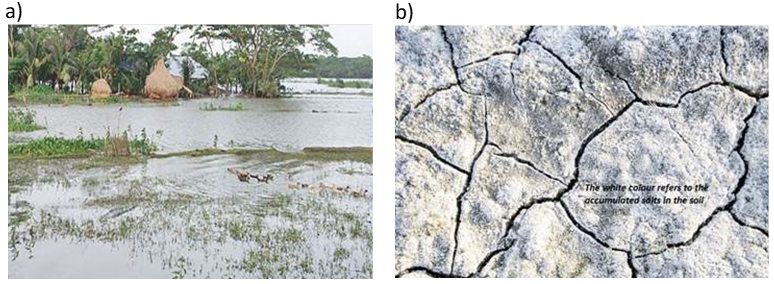
Figure 1. Waterlogging (a) and soil salinization (b) problems in agricultural lands.
Excess water may also occur due to heavy precipitation events when the soil has low permeability and/or the rainwater is trapped in the land and cannot run off [9]. To avoid these undesirable conditions, it is necessary to have a strategy that can mitigate any accumulation of excess water in the soil profile to ensure high agricultural productivity. Agricultural drainage strategies have been reported as an effective tool that allows both farmlands and urban areas to get rid of excess water [10][11], and subsurface drainage systems are well-known practices for ensuring the desired moisture conditions in crops’ root zones [12][13][14]. Due to the importance of these systems, researchers have been interested in assessing their performance and developing new technologies and approaches that help to fully understand the way in which such systems impact farmlands’ water balance.
Among all known methodologies and approaches for assessing the performance of subsurface drainage systems, mathematical models are superior since they save costs and time. DRAINMOD is one of the models that allow the quantification, on a continuous basis, of the performance of drainage and other related water management systems, as well as the assessment of various impacts of several field conditions and management practices on the performance of subsurface drainage systems [7][12].
2. Agricultural Drainage
2.1. Why Agricultural Drainage?
Water that exists in farmlands may exceed the crop water requirements, and this may occur under the following conditions:
- An excessive water supply, such as flooding irrigation.
- Intense precipitation events.
- Upward water flux from an aquifer, or even lateral seepage or runoff from adjacent lands.
If the land cannot get rid of excess water naturally (e.g., through runoff or deep percolation to aquifers), it accumulates water on its surface, causing groundwater tables to rise. The more excess water, the greater the rise in groundwater tables. If groundwater tables rise to upper soil layers where crops’ roots exist, water starts to replace oxygen in the soil profile, which hinders, or stops, the roots’ respiration. This is the “waterlogging problem” in agricultural lands [2][15].
Waterlogging and soil salinization, known as the twin menace of poor drainage conditions, have been aggravated all over the world and have become a national threat to agriculture in many countries (Figure 2). Globally, it was estimated that more than 800 million hectares of land could be considered salt-affected [16][17][18].
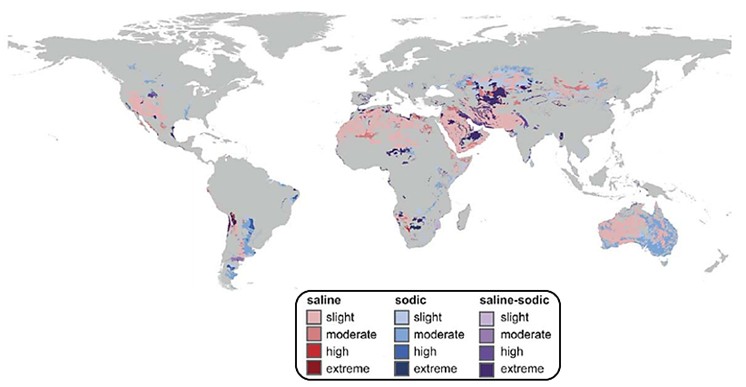
Figure 2. Global distribution of salt-affected soils. (Modified after Jothiman et al. [19]).
The above-mentioned threats of waterlogging and soil salinization highlight the great need for particular practices that help poorly drained lands get rid of their excess water to ensure the desired conditions for crops, soil, and the surrounding environment. Therefore, agricultural drainage has been practiced for decades in poorly drained farmlands to enhance their ability to get rid of the excess water through artificially constructed networks that are responsible for carrying and directing this excess water out of these lands [3][20].
In general, the benefits of practicing agricultural drainage include, but are not limited to, the following:
- It increases crop yield, as well as provides the ability to introduce new and improved cropping systems [21][22][23].
- Many studies have reported a direct relationship between poor drainage conditions and flooding susceptibility [24]. Hence, proper drainage practices can be an effective tool to mitigate flood risks and soil erosion as surface runoff decreases [25][26].
- It ensures better groundwater quality [27].
- It reduces the energy required for field machine operations, because soil compaction is decreased [3][21].
- Timelier field operations will be allowed. Consequently, crops can achieve full maturity by lengthening the growing season [3].
- As a result of the aforesaid benefits, farm income will increase while decreasing income variability.
The environment has also gained a host of benefits from the practice of agricultural drainage strategies, as follows [21]:
- It has improved the health of humans, plants, and farm animals.
Practicing agricultural drainage in wet and swampy areas led to a remarkable reduction in mosquito breeding sites, which causes a drop in the incidence and prevalence of important water-related and mosquito-transmitted diseases, e.g., malaria, yellow fever, and filariasis.
- The drainage of stagnant water results in eliminating foot rot in large animals.
- Practicing agricultural drainage mitigated nonpoint-source pollution caused by the movement of water-dissolved fertilizers from agricultural lands to the surrounding water bodies through runoff. Such mitigation helps to ensure better surface-water quality, which also reflects positively on human health.
2.2. What Is Agricultural Drainage and How Is It Being Practiced?
In simple words, agricultural drainage refers to practices that create a path for the excess water to be discharged from farmlands. Agricultural drainage has been practiced for centuries, and it helped shape many of the productive agricultural lands we see today. Modern drainage strategies were particularly prevalent toward the end of the 19th century. Between 1840 and 1890, it is estimated that around 4.9 million hectares of land were drained [3].
Practicing Agricultural Drainage
As agricultural drainage strategies aim to create a path for the excess water to be discharged from farmlands, this path can exist above or under the ground, and this is what distinguishes between so-called “Surface drainage practices” from “Subsurface drainage practices”.
Surface drainage practices mainly aim to collect (through runoff) the excess water that exists on the land surface in a set of ditches that convey this water and discharge it from the farmland. To have an effective surface drainage system, the farmland topography has to be modified to create slopes toward ditches to allow excess water on the land surface to run off smoothly toward these ditches (Figure 3). On the other hand, subsurface drainage practices aim to create an underground path that collects excess water that exists in the soil profile and discharges it, whether directly to a spot outside of the farmland or to a ditch that then discharges it from the farmland.
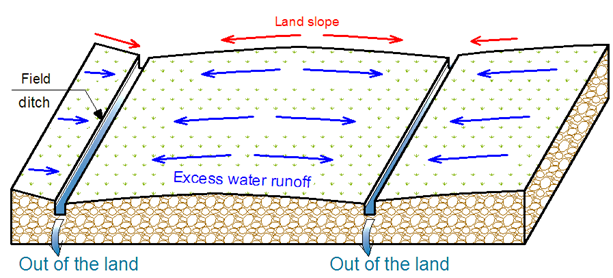
Figure 3. Surface drainage practices.
2.3. Subsurface Drainage Systems
For subsurface drainage practices, excess water is collected in underground perforated pipes that are installed at certain depths and slopes in such a way that allows this water to flow from laterals to main collectors until being discharged from the land (Figure 4). Sometimes, these underground pipes deliver excess water directly to ditches that are dug in the land, and then these ditches discharge this excess water from the land.
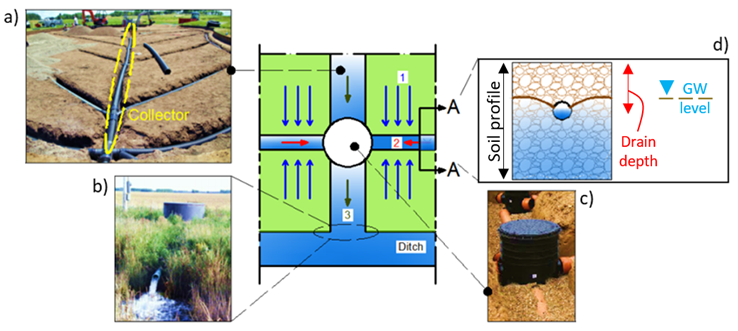
Figure 4. A typical layout of subsurface drainage systems showing (a) collectors, (b) outlets, (c) manholes, and (d) the cross-section A-A that shows drainpipes buried in the soil profile (at a certain drain depth) beside the GW table during the drainage process.
2.3.1. Layout and Components of Subsurface Drainage Systems
Figure 4 shows a simple layout of subsurface drainage systems. As shown in the figure, the main components of a subsurface drainage system are:
- Drainpipes (laterals), which are shown in section A-A (Figure 4);
- Drainpipes (collectors);
- Manholes;
- Outlets and drains.
- Drainpipes
Subsurface drainage systems are practiced mainly to get rid of the excess water that exists underground, so buried drainpipes are considered the backbone of such systems, as these pipes are the receivers and conveyors of the underground excess water. In large lands, subsurface drainage systems are designed in such a way that small-diameter drainpipes (laterals) discharge excess water into larger-diameter ones (collectors). Then, the largest-diameter pipes become responsible for conveying and discharging this water into any ditch or water body adjacent to the land. However, in small lands, laterals may be designed to discharge excess water directly into ditches or water bodies.
Drainpipes’ surfaces are perforated in a way that allows underground excess water to enter these pipes (Figure 5). However, there is a high possibility that sand and/or silt soil particles enter from these perforations and accumulate in drainpipes, resulting in clogs in these pipes and thus hindering the drainage process. Therefore, in lands that have such soil structures, drainpipes are surrounded by proper filtering materials to prevent or mitigate any clogs in these pipes. There are plenty of filtering materials, and the choice of the proper one depends on many parameters, such as the availability of these materials, soil texture, etc. (Figure 6) [28][29].
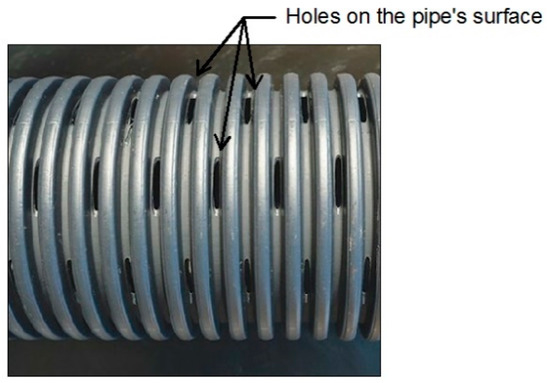
Figure 5. Drainpipe perforations.

Figure 6. Sediments in drainpipes: (a) sediment accumulation in drainpipes and (b) examples of filtering materials.
-
Collectors
Collectors are pipes with larger diameters than laterals and receive excess water from these laterals to discharge it to either larger pipes or any surrounding water body. It is preferable to have an irrigation canal at the beginning of the collector pipe (the pipe’s highest elevation) and a drain at its end (the pipe’s lowest elevation), as this helps in performing maintenance work (known as the “washing process” of the network (Figure 7)). In such a case, water is pumped with high pressure at the beginning of the collector pipe, and as a result, water will flow in the network under high pressure to remove any clogs in the collectors to ensure the best performance of the drainage process.

Figure 7. Washing process of the drainpipe network.
-
Manholes
Manholes are structures that are located at the intersections of two or more drainpipes (laterals with collectors/collectors with collectors) to mitigate the accumulation of sediments at these intersection points (Figure 8). Manholes are also implemented at specific spacings to divide the length of long collectors into smaller ones to facilitate the maintenance of these pipes. For example, if there is a certain issue (e.g., a clog) in the collector pipe, it is easy to check the sections between each adjacent manholes, rather than checking the whole length of the pipe.

Figure 8. Manholes, showing their structure and location.
-
Outlets and drains
A drainage outlet represents the point after which excess water leaves the subsurface drainage system to water bodies that surround the land. Such an outlet is mostly located at the end of a collector pipe, and, in most cases, this pipe discharges the excess water into open drains (Figure 9).
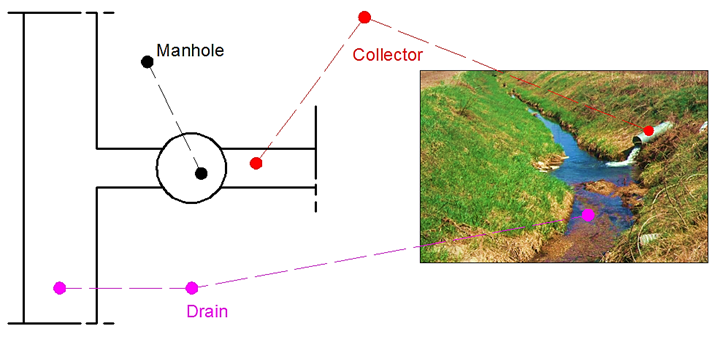
Figure 9. A typical layout showing the drainage outlet (which is mostly the end of a collector pipe).
To ensure the continuity of the drainage process, the highest designed water level in the drain or the water body (where collectors discharge excess water) should not be higher than the collector’s bottom level to prevent the submergence of collectors (outlets) in these water bodies (Figure 10).

Figure 10. Design considerations to prevent the submergence of collector pipes.
2.3.2. Special Practices in Subsurface Drainage Systems
Subsurface drainage systems have mutated and developed from only a strategy for the removal of excess water to a tool that helps to better control groundwater tables and soil moisture in agricultural lands. In the following, a brief discussion is provided about so-called “Controlled drainage [30]” and “Subirrigation [31]” practices, which are two examples of how to employ subsurface drainage practices for better control of groundwater tables and, thus, soil moisture.
Controlled Drainage Practices
Under common drainage conditions (conventional drainage), excess water moves from laterals to collectors and then is freely discharged into water bodies that surround the farmland. Therefore, under such conditions, any excess water in the soil is drained. Sometimes, there is a need to retain some or all of the excess water in the soil profile, and this occurs in the following cases:
-
Crops that require large water amounts.
For example, rice and some other crops cannot grow well until the soil is sufficiently saturated. So, the soil must retain large water amounts to achieve such saturation conditions. Under conventional drainage practices, excess water is drained and lost from the land, which decreases the water availability and thus could adversely impact crop yields. Therefore, controlled drainage practices are applied under these conditions to decrease the drainage rate or stop any drainage flux to retain the desired water amount in the land and thus ensure high crop yields [23].
-
After the application of fertilizers.
Fertilizers that are applied in agricultural lands dissolve in the soil water, and then crops’ roots extract this water to meet their requirements from fertilizers and grow optimally. Under high and unmanaged drainage rates, large amounts of this water (which contains dissolved fertilizers) are lost from the soil before being extracted by crops’ roots. This deprives crops of these fertilizers and increases the nonpoint-source pollution of surrounding water bodies that receive the drainage flux due to the dissolved fertilizers that exist in this flux. Therefore, it is sometimes preferable to decrease the drainage rate or stop any drainage flux after the application of fertilizers. Consequently, this allows crops to make the best use of these fertilizers while ensuring better quality for the surrounding water bodies [32].
Under the abovementioned cases, it is better to practice some control on the drainage flux. This can be achieved by setting a “Control structure” before the outlet. This control structure has something like a small gate that can be moved up and down to achieve the desired drainage rates (Figure 11).
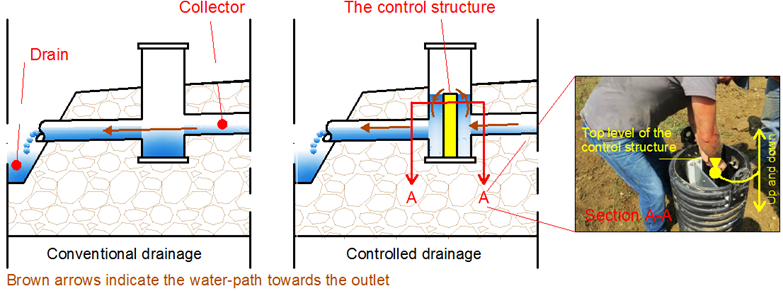
Figure 11. Conventional vs. controlled drainage practices.
Under controlled drainage practices, excess water does not flow directly to outlets. Rather, it accumulates in the control structure, or in the manhole that contains that control structure, until it reaches a level higher than the top of the control structure, and then drainage starts (Figure 11).
Subirrigation Practices
Apart from what is established in minds about drainage systems, namely, that they are installed to only lower groundwater tables in the soil profile, these systems can be managed in a different way (subirrigation practices) to exert the reverse action. Under subirrigation practices, water is pumped back into collectors to reach the laterals. As a result, water flows from these laterals to the soil profile (through the openings on the surfaces of these laterals). This increases the water availability in the soil profile, especially the root zone, and causes groundwater tables to rise (Figure 12).

Figure 12. Subirrigation practices.
2.3.3. Advantages and Disadvantages of Subsurface Drainage Practices
Compared to surface drainage practices, the main advantage that characterizes subsurface drainage practices is the high control of the drainage rate, and this, in turn, results in several advantages [14][25]:
- Better control of groundwater tables.
- Mitigation of the degradation of water body quality that results from nonpoint-source pollution when fertilizers that are dissolved in drainage water discharge in these water bodies.
Most components of subsurface drainage systems exist underground, so the installation of these systems does not cause significant losses in the area of agricultural lands compared to surface drainage systems.
As previously stated, practicing subsurface drainage strategies mitigates the runoff to adjacent water bodies, which may save them from the so-called “gully erosion” and ensure better conditions for the maintenance of their cross-sections [33].
On the other hand, the major disadvantage of subsurface drainage systems is the high cost of installation. In addition, such systems require periodic maintenance to ensure the high performance of the drainage process.
2.4. Soil Type and Climate Patterns as Significant Determinants When Deciding the Best Drainage Strategy (Surface or Subsurface) in Agricultural Lands
To decide the best drainage strategy (whether surface or subsurface) for a particular land, it is necessary to have preliminary knowledge of the excess water fate in the land. Such a fate in agricultural lands depends largely on the soil characteristics and weather patterns. In principle, the excess water that exists in farmlands has two major fates: runoff and infiltration.
- If the soil is highly permeable, then excess water (which exists on the land surface) easily percolates into the soil profile in a relatively short time. In this case, subsurface drainage strategies are the ideal choice since most of the excess water will exist underground in the soil profile.
- For low-permeability soils, excess water (which exists on the land surface) takes a relatively long time to percolate into the soil profile, resulting in the accumulation of this water on the land surface. If this stagnant or retained water exceeds the surface depression capacity of the land, then runoff begins. Under such conditions, most of the excess water exists on the land surface and not in the soil profile, and thus, surface drainage strategies are the ideal choice in these lands to collect the excess water through runoff.
- Sometimes, people may have intense precipitation patterns in lands characterized by high-permeability soils. Under such conditions, the precipitation rate may exceed the percolation of excess water into the soil profile. This may result in excess water accumulation on the land surface, which makes surface drainage strategies necessary in these lands despite having relatively high-permeability soil in the land.
- If the climate pattern varies during the year in a particular land, it may be better to use a combination of both surface and subsurface drainage strategies to collect excess water runoff (e.g., due to heavy precipitation events) and get rid of underground excess water (when existing).
In addition to the abovementioned role of soils and climate patterns in deciding the best drainage strategies in agricultural lands, soil texture plays a dominant role in deciding the best design layout of drainage systems. Therefore, it is indispensable to properly consider different soil textures and climate patterns that exist in a particular area when deciding on the best drainage strategies and practices.
References
- Klt, K. Plant Growth and Yield as Affected by Wet Soil Conditions Due to Flooding or Over-Irrigation. 2004. Available online: https://extensionpublications.unl.edu/assets/html/g1904/build/g1904.htm#:~:text=Plant%20Growth%20and%20Yield%20as%20Affected%20by%20Wet,proper%20irrigation%20management%20strategies%20can%20limit%20negative%20impacts (accessed on 28 December 2022).
- Singh, A. Soil Salinization and Waterlogging: A Threat to Environment and Agricultural Sustainability. Ecol. Indic. 2015, 57, 128–130.
- Ghane, E. Agricultural Drainage. Mich. State Univ. Ext. Bull. E 2018, 3370. Available online: https://www.canr.msu.edu/resources/agricultural-drainage (accessed on 28 December 2022).
- Zeng, R.; Chen, T.; Zhang, H.; Cao, J.; Li, X.; Wang, X.; Wang, Y.; Yao, S.; Gao, Y.; Chen, Y. Effect of Waterlogging Stress on Grain Nutritional Quality and Pod Yield of Peanut (Arachis hypogaea L.). J. Agron. Crop Sci. 2022.
- De Castro, J.; Hill, R.D.; Stasolla, C.; Badea, A. Waterlogging Stress Physiology in Barley. Agronomy 2022, 12, 780.
- Singh, A. An Overview of Drainage and Salinization Problems of Irrigated Lands. Irrig. Drain. 2019, 68, 551–558.
- Skaggs, R.W.; Youssef, M.A.; Chescheir, G.M. DRAINMOD: Model Use, Calibration, and Validation. Trans. ASABE 2012, 55, 1509–1522.
- Singh, A. Poor-Drainage-Induced Salinization of Agricultural Lands: Management through Structural Measures. Land Use Policy 2019, 82, 457–463.
- Alam, H.E. Seasonal Waterlogging Variation in the Sylhet City Corporation Area, Bangladesh-an Integrated Geospatial Approach. JGISE J. Geospat. Inf. Sci. Eng. 2022, 5, 8–14.
- Ren, X.; Wang, S.; Yang, P.; Tao, Y. Experimental and Modeling Evaluation of Siphon-Type Subsurface Drainage Performance in Flooding and Waterlogging Removal. Agric. Water Manag. 2023, 275, 108031.
- Islam, M.N.; Bell, R.W.; Barrett-Lennard, E.G.; Maniruzzaman, M. Shallow Surface and Subsurface Drains Alleviate Waterlogging and Salinity in a Clay-Textured Soil and Improve the Yield of Sunflower in the Ganges Delta. Agron. Sustain. Dev. 2022, 42, 16.
- Skaggs, R.W. Drainmod: Reference Report; Methods for Design and Evaluation of Drainage-Water Management Systems for Soils with High Water Tables. 1985. Available online: https://www.bae.ncsu.edu/agricultural-water-management/drainmod/manuals/ (accessed on 28 December 2022).
- Song, Y.; Park, M. A Study on the Development of Reduction Facilities’ Management Standards for Agricultural Drainage for Disaster Reduction. Sustainability 2021, 13, 9595.
- Askri, B.; Khodmi, S.; Bouhlila, R. Impact of Subsurface Drainage System on Waterlogged and Saline Soils in a Saharan Palm Grove. CATENA 2022, 212, 106070.
- Singh, S. SOIL WATERLOGGING: CAUSE, IMPACT, AND MANAGEMENT. In Soil Constraints on Crop Production; Cambridge Scholars Publishing: Cambridge, UK, 2022; p. 62.
- Shahid, S.A.; Zaman, M.; Heng, L. Soil Salinity: Historical Perspectives and a World Overview of the Problem. In Guideline for Salinity Assessment, Mitigation and Adaptation Using Nuclear and Related Techniques; Springer: Berlin/Heidelberg, Germany, 2018; pp. 43–53.
- Shahid, S.A.; Zaman, M.; Heng, L. Introduction to Soil Salinity, Sodicity and Diagnostics Techniques. In Guideline for Salinity Assessment, Mitigation and Adaptation Using Nuclear and Related Techniques; Springer: Berlin/Heidelberg, Germany, 2018; pp. 1–42.
- Blann, K.L.; Anderson, J.L.; Sands, G.R.; Vondracek, B. Effects of Agricultural Drainage on Aquatic Ecosystems: A Review. Crit. Rev. Environ. Sci. Technol. 2009, 39, 909–1001.
- Jothimani, M.; Dawit, Z.; Mulualem, W. Flood Susceptibility Modeling of Megech River Catchment, Lake Tana Basin, North Western Ethiopia, Using Morphometric Analysis. Earth Syst. Environ. 2021, 5, 353–364.
- Grigg, B.C.; Southwick, L.M.; Fouss, J.L.; Kornecki, T.S. Drainage System Impacts on Surface Runoff, Nitrate Loss, and Crop Yield on a Southern Alluvial Soil. Trans. ASAE 2003, 46, 1531.
- Madramootoo, C.A.; Johnston, W.R.; Willardson, L.S. Management of Agricultural Drainage Water Quality; Food & Agriculture Org.: Rome, Italy, 1997; Volume 13, ISBN 92-5-104058-3.
- Ghane, E.; Fausey, N.R.; Shedekar, V.S.; Piepho, H.P.; Shang, Y.; Brown, L.C. Crop Yield Evaluation under Controlled Drainage in Ohio, United States. J. Soil Water Conserv. 2012, 67, 465–473.
- Dou, X.; Shi, H.; Li, R.; Miao, Q.; Tian, F.; Yu, D.; Zhou, L.; Wang, B. Effects of Controlled Drainage on the Content Change and Migration of Moisture, Nutrients, and Salts in Soil and the Yield of Oilseed Sunflower in the Hetao Irrigation District. Sustainability 2021, 13, 9835.
- Manawi, S.M.A.; Nasir, K.A.M.; Shiru, M.S.; Hotaki, S.F.; Sediqi, M.N. Urban Flooding in the Northern Part of Kabul City: Causes and Mitigation. Earth Syst. Environ. 2020, 4, 599–610.
- Kamra, S.K. An Overview of Subsurface Drainage for Management of Waterlogged Saline Soils of India. Water Energy Int. 2015, 58, 46–53.
- Pandya, A.B.; Singh, S.; Sharma, P. Climate Change and Its Implications for Irrigation, Drainage and Flood Management. In Water Security Under Climate Change; Springer: Berlin/Heidelberg, Germany, 2022; pp. 95–110.
- Awad, A.; El-Rawy, M.; Abdelmawgoud, A.H. Agricultural Drainage Strategies in Egypt as a Protection Tool Against Groundwater Contamination by Fertilizers: An Overview. In Sustainability of Groundwater in the Nile Valley, Egypt; Springer Nature: Cham, Switzerland, 2022; pp. 203–233.
- Ead, S.A.; Abdelmonem, Y.; El-Mergawey, E.S. Study of the Characteristics of Drainage Filters. Available online: https://link.springer.com/book/10.1007/978-3-031-12676-5 (accessed on 28 December 2022).
- Martin, W. Surface Water Treatment by Roughing Filters: A Design, Construction and Operation Manual. 1996. Available online: https://www.semanticscholar.org/paper/Surface-Water-Treatment-by-Roughing-Filters%3A-A-and-Wegelin/dfd77144a184b7c0036d42c7a9c4d8d656cd646f (accessed on 28 December 2022).
- Wesström, I.; Messing, I.; Linner, H.; Lindström, J. Controlled Drainage—Effects on Drain Outflow and Water Quality. Agric. Water Manag. 2001, 47, 85–100.
- Ferrarezi, R.S.; Weaver, G.M.; Van Iersel, M.W.; Testezlaf, R. Subirrigation: Historical Overview, Challenges, and Future Prospects. HortTechnology 2015, 25, 262–276.
- Wang, Z.; Shao, G.; Lu, J.; Zhang, K.; Gao, Y.; Ding, J. Effects of Controlled Drainage on Crop Yield, Drainage Water Quantity and Quality: A Meta-Analysis. Agric. Water Manag. 2020, 239, 106253.
- Lin, H.; Bai, L.; Luo, M.; Wang, Z.; Yang, D.; Zhang, B.; Lin, Y. A Multi-Criteria Framework for Identification of Gully Developmental Stages Based on UAV Data—A Case Study in Yuanmou County, Yunnan Province, SW China. Int. J. Environ. Res. Public Health 2022, 19, 8202.
More
Information
Subjects:
Water Resources; Agricultural Engineering
Contributors
MDPI registered users' name will be linked to their SciProfiles pages. To register with us, please refer to https://encyclopedia.pub/register
:
View Times:
1.7K
Revisions:
2 times
(View History)
Update Date:
16 Jan 2023
Notice
You are not a member of the advisory board for this topic. If you want to update advisory board member profile, please contact office@encyclopedia.pub.
OK
Confirm
Only members of the Encyclopedia advisory board for this topic are allowed to note entries. Would you like to become an advisory board member of the Encyclopedia?
Yes
No
${ textCharacter }/${ maxCharacter }
Submit
Cancel
Back
Comments
${ item }
|
More
No more~
There is no comment~
${ textCharacter }/${ maxCharacter }
Submit
Cancel
${ selectedItem.replyTextCharacter }/${ selectedItem.replyMaxCharacter }
Submit
Cancel
Confirm
Are you sure to Delete?
Yes
No




